Bruges
Bruges remains one of Europe’s best preserved cities and has both charm and intrigue oozing in abundance out of its cobblestone streets.
The fairy-tale city is a place that lives and breathes history. Visiting Bruges is like travelling back in time to the Middle Ages. It is both magical and authentic.
I had previously travelled to Bruges in the past, but not with my wife Holly. And this time we also would be joined by a third traveller in the shape of our one-year-old son, Jacob.
The trip to Belgium would be Jacob’s first time out of the UK. With his pristine passport in hand (the photo they use in it is perhaps the cutest thing I’ve ever seen) this would be our first adventure abroad as a family of three!
A little nervous at the prospect? Yes. Excited about it? Absolutely! It’s my sincere hope that Jacob develops as much of a love for travel as both his parents have.
To make matters easier for ourselves, we decided that this “tester” trip would be made as simple as possible. It led us to choose a destination that we could reach by train (so to avoid having to do an airport) and one that we’d be able to take at a fairly slow pace, despite it being in the height of summer (August).
Bruges quickly became that location.
The city of Bruges is situated in the enchanting region of Flanders in the north-west of Belgium.
With its unquestionable charm, picturesque canals, and well-preserved architectural treasures, Bruges stands as a testament to the rich history and cultural heritage of this remarkable country.
Bruges traces its origins back to the Roman era when it served as a coastal settlement and trading hub. However, it was during the Middle Ages that the city truly flourished, becoming one of the wealthiest and most important centres of commerce in Europe. Bruges emerged as a vital link in the Hanseatic League, a powerful trading network that connected the Baltic and North Sea regions.
The 14th and 15th centuries marked the golden age of Bruges. The city’s strategic location, along with its flourishing textile industry and bustling port, attracted merchants from all corners of the globe. It quickly became renowned for its wool, cloth, and luxury goods, making it a prosperous trading centre. The opulence and wealth of the city are reflected in its stunning architectural landmarks, which still grace the city-scape today.
While Bruges experienced periods of decline in the following centuries, the city’s historical significance was never forgotten. In the late 19th century, a concerted effort was made to restore and preserve its architectural heritage, ensuring that Bruges would remain a cherished destination for generations to come.
The city is a veritable open-air museum of architectural wonders. The city’s historic centre – a UNESCO World Heritage site – boasts an impressive collection of Gothic, Renaissance, and Romanesque buildings.
Bruges is often referred to as the “Venice of the North” due to its intricate network of canals. These waterways add to the city’s charm, offering visitors scenic boat rides and an opportunity to explore Bruges from a different perspective. Meandering through the cobblestone streets, lined with quaint houses, elegant mansions, and charming squares, really is like stepping into a fairy-tale.
The city remains a living testament to Belgium’s glorious past. Its cobbled streets, enchanting canals, and magnificent architecture create an ambiance that transports visitors back in time.

Bruges is a dream destination for first-time travellers to Belgium.
So what should a first time visitor know before embarking on a Bruges adventure and immersing themselves in the city’s romantic atmosphere?
The first thing to consider is the weather.
August (the month Holly, Jacob and I visited in) is a popular and wonderful time to visit Bruges, as the city experiences mild and pleasant weather. The average temperature during this month ranges from 15°C to 22°C (59°F to 72°F). However, it is a good idea to pack layers, as the weather can be unpredictable at times. Don’t forget to bring an umbrella or raincoat, as rainfall is possible throughout the year.
The second thing to think about is the currency.
The official currency in Belgium is the Euro (EUR) and it’s recommended to carry some cash for small purchases and establishments that may not accept cards. At the time of writing £1 got you €1.15. Currency exchange services are available at banks, exchange offices, train stations and major airports while ATMs can be found throughout the city, allowing you to withdraw cash.
Another area to consider is the time difference from the UK. Bruges is located in the Central European Time Zone (CET) and during August, Bruges is one hour ahead of the UK. This hour you’ll lose when you travel to Belgium but gain back when you arrive back in the UK.
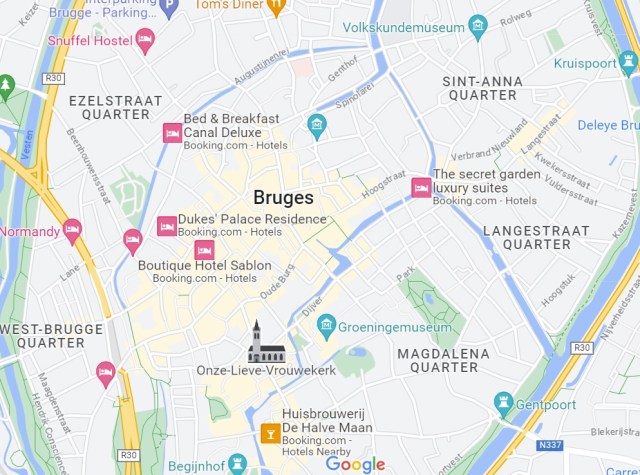
The next thing to consider is the power points.
For Belgium there are two associated plug types, types C and E. Plug type C is the plug which has two round pins and plug type E is the plug which has two round pins and a hole for the socket’s male earthing pin. Belgium operates on a 230V supply voltage and 50Hz.
A final consideration is the language.
For a small country, Belgium likes to add a challenge when it comes to languages spoken. By this I mean that the official languages in Belgium are Dutch, French, and German.
Which language is the primary language will greatly depend on where in the country you are. For instance, in the capital city, Brussells, the main language is French (although signs in the Metro also appear in Dutch). However, in Bruges, the primary language spoken is Dutch.
Visitors who only speak English (like Holly and I – and hopefully Jacob in the future) need not fear too much though, as English is widely understood and spoken by locals, particularly in tourist areas, hotels, restaurants, and shops, meaning you won’t face a significant language barrier while exploring Bruges. That said, it’s always polite to learn a few basic phrases in the local language.
Knowing simple words like hello (hallo), goodbye (tot ziens), please (alsjeblieft) and thank you (bedankt) in the local language can go a long way to smoothing interactions with local people.
Getting there
As mentioned, we wanted to make sure this journey would be as straight-forward and as hassle free as possible.
So while it is possible to fly to Belgium (you cannot fly directly to Bruges from the UK so you have to fly to Brussels and then catch a local train), from the UK it makes far more sense to get the Eurostar.
Booking out tickets online we paid a total of £246 for two return adult tickets to Brussels from London St. Pancras International in August (due to Jacob’s age he sat on our laps and was free of charge). It’s worth noting that prices will vary depending on the time of year you are travelling and the time of day you wish to go.
For those unfamiliar with the train, the Eurostar is a high-speed train service that runs between the UK, France, Belgium and the Netherlands. The Eurostar provides a stress-free and time-efficient way to reach a destination.
If you’re travelling from London as we did, you’ll begin your Eurostar journey at London St Pancras International Station. Before Covid-19, there were also options from Ebbsfleet International and Ashford International, however, at the time of writing, these have yet to come back and it’s unclear if they ever will!
After a smooth check-in process, we boarded the Eurostar train, which whisked the three of us away on a two-and-a-half-hour journey to Brussels. Sitting back we watched as the English countryside transformed itself into the picturesque landscapes of Belgium.
Upon arrival in Brussels we disembarked from the Eurostar (which arrives on either platform one or two) onto the Belgium platform marking Jacob’s first steps abroad.


Having soaked in this momentous occasion, we made our way to the connecting train to Bruges. To avoid having to locate a ticket office in the busy Brussel terminal, I’d pre-booked return tickets for us – via The Trainline – between Brussels and Bruges for just £68.30 in total.
Brussels Midi/Zuid station (to give it, its full name) offers frequent and convenient connections to Bruges, with journey times ranging from one to two hours. Most take around one and a quarter hours with a couple of stops along the way. In total there are 75 trains every day travelling the 55 miles between the two cities so options are plentiful.
To help, it’s worth remembering that Belgian domestic trains to Bruges and Ghent leave from platforms nine to 16, so worth heading in that direction when you arrive in Brussels.
The magic of the city hits you as soon as the train pulls into Bruges railway station. Exiting via the main entrance and exit, we made the relatively short walk towards the heart of the city to find our accommodation.

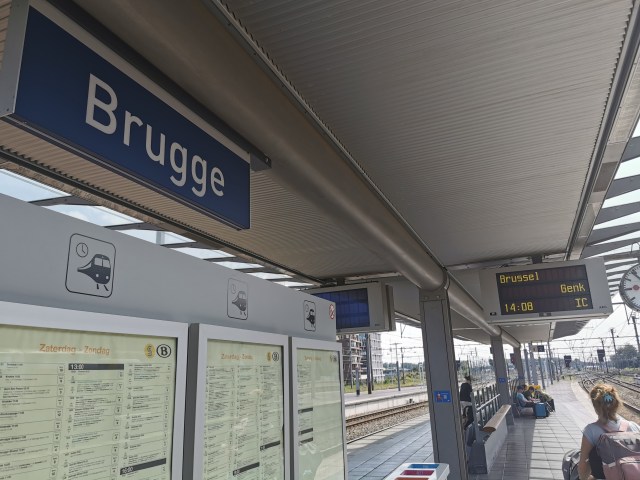
Where to stay
The first thing to say is that Bruges has a wide variety of hotels and other types of accommodation readily available all-year-round that suits most budgets.
For this trip, however, Holly and I needed to ensure that where we stayed had facilities for Jacob.
So unlike most trips we take – where we look for a nice AirBnB to stay in – for this one with Jacob we wanted to ensure that there were people available to assist easily should we need anything during our stay.
It meant that for our trip to Bruges, we found a delightful B&B – BNB in Bruges – that exceeded our expectations in every way.
Nestled in the heart of the city on a road called Riddersstraat, this accommodation met all our needs for our short stay. It was competitively priced and had facilities to ensure Jacob would be able to sleep here as well.
Before our arrival at the B&B, I’d received a text message and email confirming how to let ourselves into the building and that our room key would be in the door waiting for our arrival.
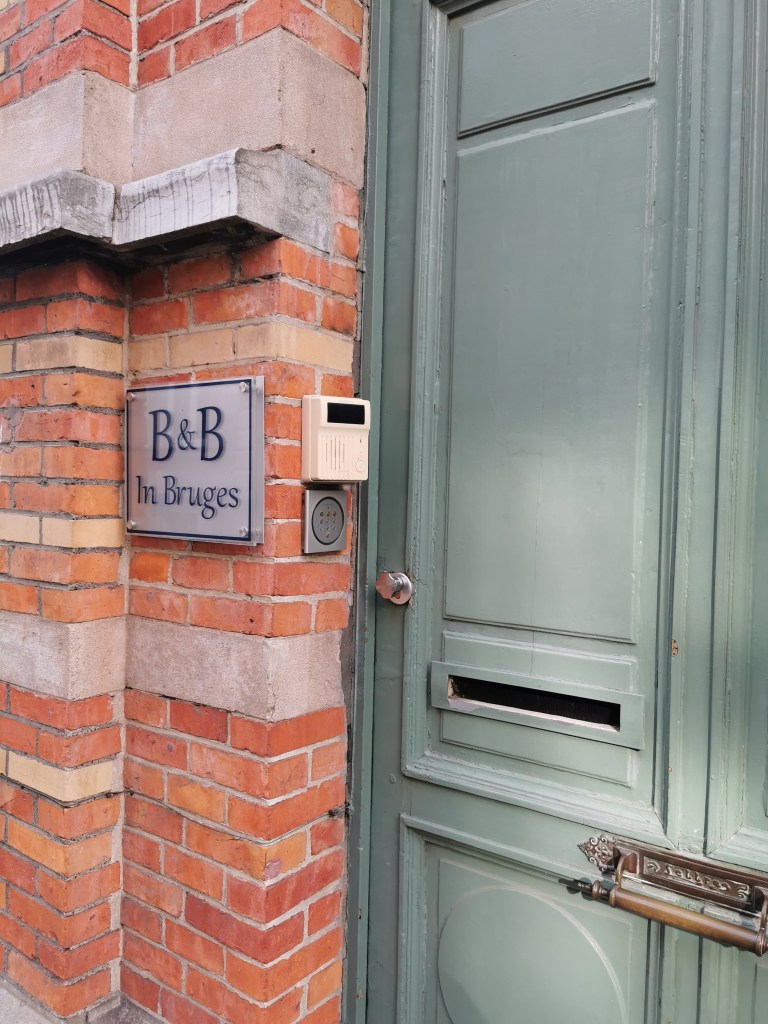

Our room on the top floor – and aptly named Room with a View – was simple, yet, tastefully decorated; with a rustic yet elegant ambiance. It boasted all the essential amenities required for a comfortable stay. The large, plush bed promised restful nights after a day of exploring the city, and the addition of a baby cot for our little one was one of the main reasons we selected this accommodation.
The en-suite bathroom featured modern fixtures and complimentary toiletries, ensuring our convenience throughout our stay.
The B&B’s location couldn’t have been more perfect.
Situated in the heart of Bruges, it allowed us to immerse ourselves in the city’s rich history and culture effortlessly. The iconic attractions, such as the medieval Belfort and the historic Markt Square were all within a leisurely stroll from the B&B. Additionally, the picturesque canals of Bruges were just a stone’s throw away, offering idyllic scenery.
Considering the location, facilities, and personalised service, the cost of €450 (around £390) for a three-night stay for two adults and a baby felt like a reasonable investment. While breakfast wasn’t included, the nearby cafes and bakeries provided us with a chance to sample delicious local treats each morning.
Our stay at the BNB in Bruges left us with cherished memories of this enchanting city. The cozy room, prime location, and family-friendly amenities made it an excellent choice for our little families first trip abroad together.
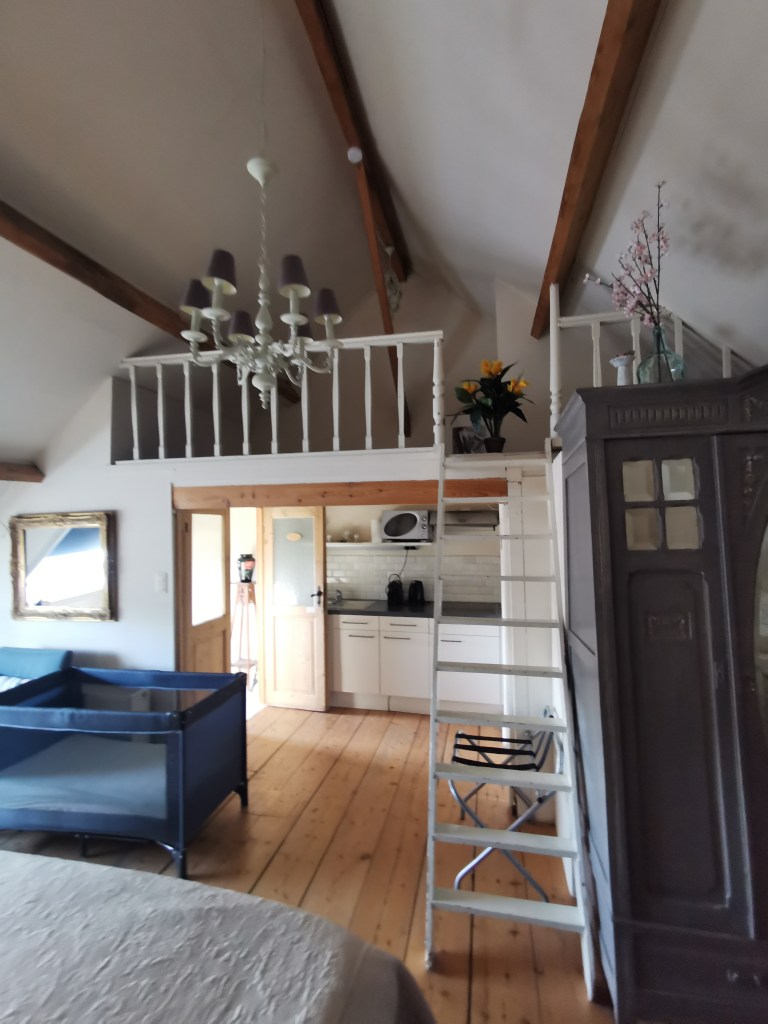
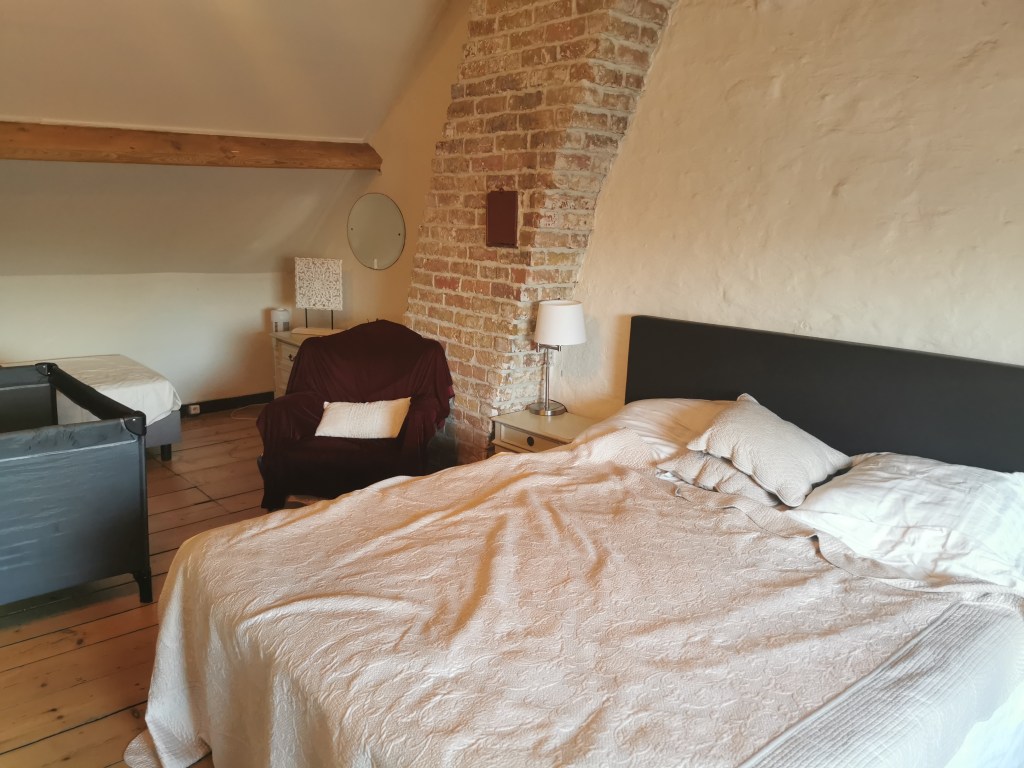
Getting around
Bruges is a compact city that can easily be explored on foot. Its well-preserved medieval centre makes walking the best way to experience the city’s charm.
Due to it’s relatively small size and its pedestrian-friendly layout, Bruges is extremely easy to navigate on foot. And while there are other options available, including cycling along the cities cobbled lanes (a firm favourite among the locals), boat trips along the city’s canals or taking a horse-drawn carriage, walking is the easiest and most cost-effective method to get around this small city.
Overall, walking around Bruges is a delightful experience, that offered us a unique opportunity to immerse ourselves in the city’s rich history and beautiful atmosphere.
To give you an idea of the distances you’ll need to walk, a gentle stroll from the train station – located in the south-west corner of the inner city to our accommodation – which was fairly centrally located – took us around 25 minutes (with luggage and a baby) to travel the fairly flat 1.8km route.
So, while public transportation is also available if you need to travel longer distances or prefer not to walk, we found it far more rewarding to stroll through the streets and soak in everything Bruges had to offer.
With Jacob in his pushchair – and Holly and I donning a pair of comfortable shoes – each day we would set-out on a leisurely stroll that allowed us to get lost in the magic of Bruges.

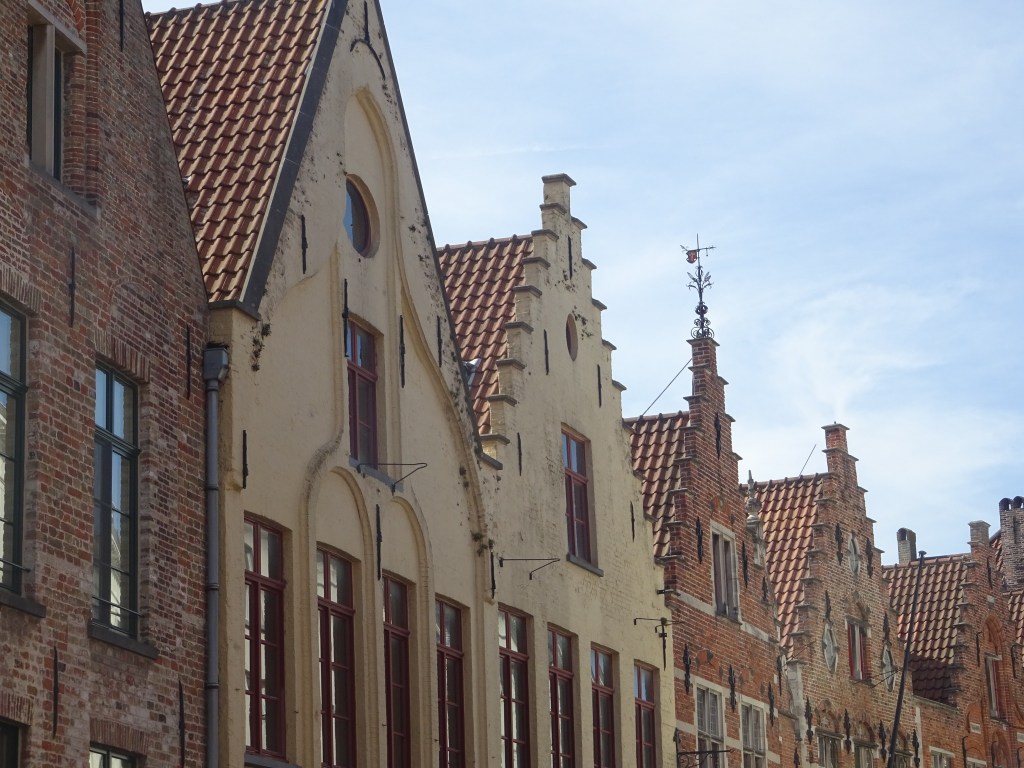
Top sites
There are many attractions that you should see in Bruges but at the front of any visitors list will be the Belfort of Bruges; the city’s primary focal point located on the edge of the famous Markt.
This imposing tower is a sight to behold and, while a lot of Bruges is low-lying, the Belfort stands proud and tall within the city providing superb panoramic views of the surrounding area.
I had plans to climb the Belfort but with a one-year old child in tow, these plans had to be thought through a little more. We decided that the best bet was for me to ‘wear’ Jacob on my chest and climb the tower carrying him in this manner.
To give us the “easiest” climb possible, we headed to the Belfort for opening (which at the time of our visit was 9am – but in the winter months is 10am). This way, there were as few people as possible climbing the tower at the same time as us.
The main issue is that, to reach the top of the Belfort, you’ll need to conquer a formidable 366 steps. To add a complication, the way up is also the way down, meaning that the higher you get the more narrow it is, making passing points hard to come by.
While this may seem like a challenging climb (and with a baby it even more tricky), the reward at the top is more than worth the effort.
As you ascend, you’ll pass by the massive bells that give the tower its name with each step bringing you closer to the spectacular views that await.
Once we’d made it to the summit, we were greeted by a sweeping, 360-degree vista of Bruges and its picturesque surroundings. From this vantage point, you can see the city’s charming canals, historic buildings, and quaint cobblestone streets. The views – I’m told – are particularly stunning during sunset when the warm hues of the setting sun cast a magical glow over the city.
During our stay, I also learnt that the Belfort used to act as a watchtower for the city. While the building looks like a church, it is in no way linked to religion. Instead people used to stand at the top and keep an eye on the city. This included people watching for fires. Should one break out, they would chime the bells and point flags in the direction of the blaze in order to signify where people needed to rush to, in order to put out the fire and cause minimal damage. Ingenious!
With that in mind, the Belfort isn’t just about the view. it’s also a window into Bruges’ rich history. Inside the tower, you’ll find a museum that showcases the story of the Belfort and the city itself. The various exhibitions are spread across the floors as you ascend giving you ample opportunity to explore artifacts and historical documents that bring the past to life.
Perhaps what the Belfort is most famous for (other than being the focus of the rather awesome ending of the film In Bruges), the Belfort is home to a carillon of 47 melodious bells, and they play an integral role in the city’s daily life. These bells chime regularly throughout the day, offering a delightful soundtrack to a visit.
To experience all that the Belfort has to offer, including the climb to the top and access to the museum, you’ll need to purchase a ticket. The current entrance fee for adults is €15 per person while children under the age of seven (as in Jacob’s case) are free of charge. Given the unforgettable experience and the chance to immerse ourselves in Bruges’ history and culture, this felt like an extremely reasonable price.

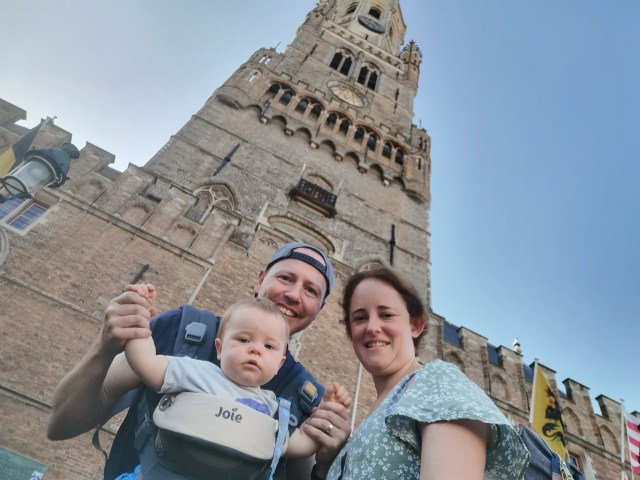

Going hand-in-hand with the Belfort, nestled in the heart of Bruges, sits the Markt Square.
This historic square, also known simply as “the Markt,” is not only a must-visit destination for travellers but also one that we found ourselves returning to time and time again during our stay in the city.
As mentioned, one of the standout features of Markt Square is the towering Belfort of Bruges. But there is much more to see and do in the square.
Strolling through the Markt, we found ourselves surrounded by a stunning collection of historic buildings showcasing various architectural styles. The Provincial Court, the Old Civil Registry, and the iconic colourful facades of the guildhalls transported us back in time.
While we didn’t do this, the square is also the place to get on a horse-drawn carriage ride. These charming (albeit quite costly) rides offer a unique perspective of the square, and the clip-clopping of horse hooves against the cobblestone streets adds to the enchanting atmosphere.
Markt Square regularly hosts an array of market stalls. On a weekly basis there are multiple stalls with a host of items from traditional Belgian chocolates and lace to handcrafted souvenirs and local foods.
Food lovers are covered as well. Numerous restaurants and cafes line the square, offering both Belgian classics and international cuisine.



If – like us – you a chocoholic looking for a delectable adventure then you need look no further than Choco-Story.
This delightful museum offers a tantalising journey into the world of chocolate, from its fascinating history to hands-on experiences, all topped off with a scrumptious chocolate tasting at the end.
Choco-Story, Bruges, is conveniently located in the heart of the city, at Wijnzakstraat 2, just a short walk from the iconic Markt. We made sure that we timed our visit for opening time (which is 10am) so we could enjoy easy access with Jacob.
As the museum is split over numerous floors, we left the pram on the lower floor in the locker area, and carried Jacob around the exhibits.
For a mere €13 per adult, we gained access to a world of chocolatey wonder. Children under six years old enter for free which meant we were not charged for Jacob, and there are discounts available for students, seniors, and groups. It’s a small price to pay for the rich experience that awaits you.
Once inside, you begin your journey by delving into the history of chocolate. Choco-Story’s engaging exhibits take you back in time to the ancient civilisations that first discovered cacao and guide you through its transformation into the beloved treat we know today.
Choco-Story also offers informative demonstrations where skilled chocolatiers showcase the art of chocolate-making, revealing the secrets behind crafting these sweet delights.
You can also marvel at an impressive collection of antique chocolate-making machinery. These fascinating artifacts showcase the evolution of chocolate production technology over the years.
For younger visitors there are plenty of interactive displays to enjoy.
Youngsters (or those who are just young at heart) can try their hands at grinding cacao beans, mold their own chocolate creations, and learn about the chocolate production process in an engaging and educational manner.
One issue we found is that numerous exhibits were not working during our visit so this may prove disappointing if that’s the case for younger guests.
The grand finale of any visit is, undoubtedly, the chocolate tasting. Let’s be honest, it’s the bit every guests really wants. After immersing ourselves in the world of cocoa, we indulged (perhaps over-indulged) our taste buds with a mouthwatering selection of Belgian chocolates.
Choco-Story in Bruges is a delightful experience that combines history, culture, and, most importantly, the joy of chocolate. Whether you’re a true chocolate aficionado or simply have a sweet tooth, this museum promises a memorable and delicious adventure.

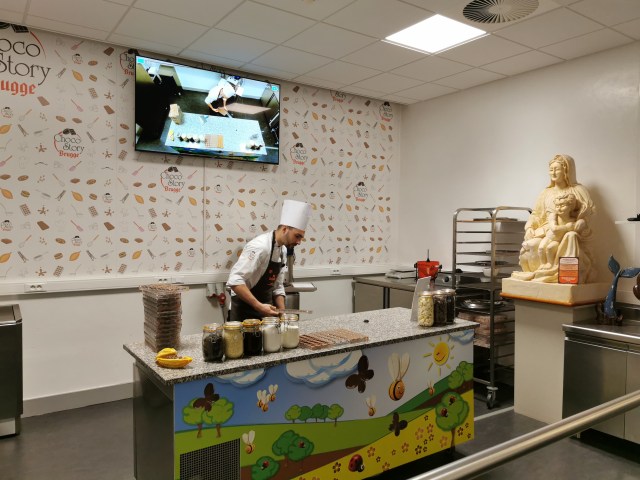
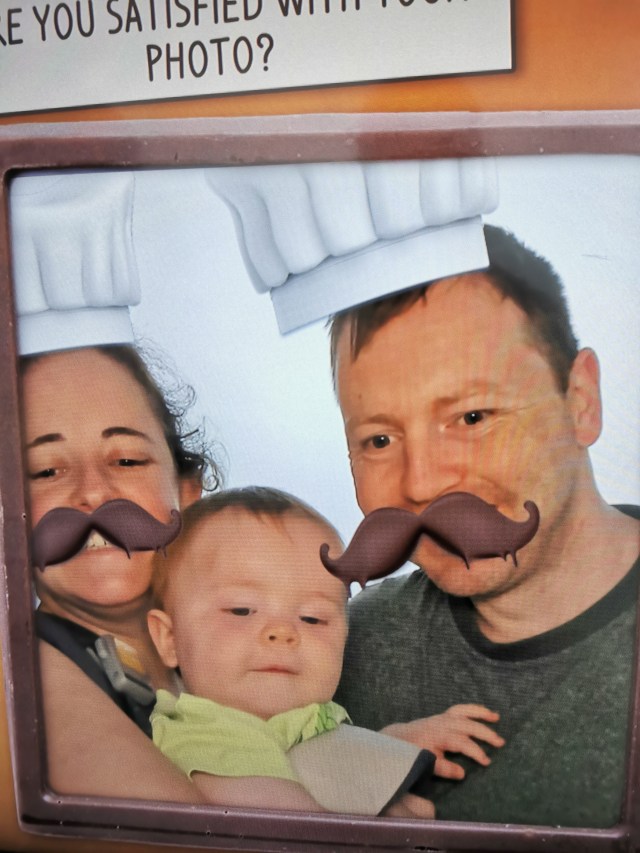
The next stop we made was to the beautiful and bizarre world of the Salvador Dali Museum.
This museum perfectly showcases the eccentricity and imagination of one of the most renowned surrealist artists the world has ever known.
Nestled on the outskirts of the Markt square next to the Belfort, this museum is a haven for art enthusiasts, dreamers, and anyone seeking a surreal escape from the ordinary.
For just €10 per adult – with children under seven entering for free – the museum offers a fascinating journey through Dali’s artistic evolution and showcases a diverse range of his works, including paintings, sculptures drawings, and some of his choice quotes.
The museum houses a remarkable collection of Dali’s paintings, often including some of his most famous works such as “The Elephants,” “The Persistence of Memory,” and “Galatea of the Spheres.”
Furthermore, Dali’s creativity extended beyond the canvas, and the museum displays an array of his sculptures, each with its own surreal twist. Be prepared to encounter melting clocks and distorted forms that challenge conventional perceptions of art.
The museum also often hosts temporary exhibitions that showcase Dali’s contemporaries and artists influenced by his work, adding a fresh and dynamic element to a visit.
The Salvador Dali Museum in Bruges is a surreal oasis where the eccentric and imaginative world of Salvador Dali comes to life. Whether you’re a devoted art enthusiast or – like us – simply curious about the world of surrealism, this museum promises an unforgettable and mind-bending experience that’s well worth the visit.
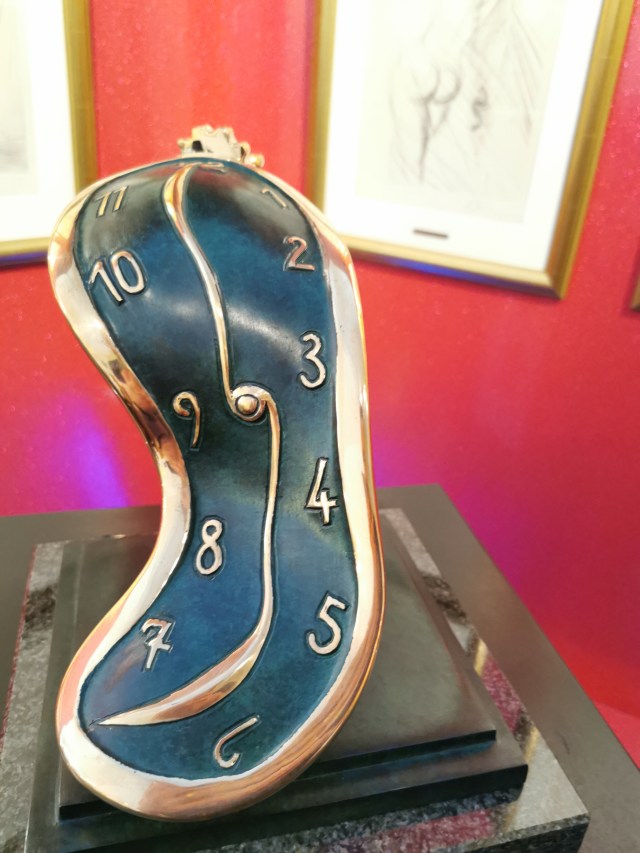


Wherever you go in Bruges, you are spoiled for choice when it comes to stunning views and breathtaking vistas. However, one that adorns many visitors’ photo albums is that of the exceptionally beautiful and tranquil Rozenhoedkaai.
Tucked away a mere 10 minute walk from the centre, the Rozenhoedkaai is a photogenic spot that showcases the city’s timeless allure. This iconic location is situated along the Dijver canal, where the historic buildings are gracefully reflected in the calm waters.
The name “Rozenhoedkaai” translates to “Quay of the Rosary” in English, reflecting the area’s historical connection to a nearby convent that once existed.
Holly, Jacob and I ensured that we visited this spot early one morning which is my top tip for unlocking one of the best experiences Bruges has to offer; the view without the crowds!
In the early hours, before the city fully awakens, Rozenhoedkaai is a serene paradise. The soft, golden light of the sunrise bathes the canal and the surrounding buildings in a warm, ethereal glow. The quietude of the morning allows you to truly soak in the beauty and capture it in photographs without the bustling crowds that tend to gather later in the day.
The lack of crowds also enhances the sense of tranquillity that Rozenhoedkaai exudes. It’s a moment of solace amidst the busyness of travel, a chance to reflect and appreciate the sheer magnificence of this picturesque city.
Rozenhoedkaai provides endless opportunities to capture the essence of Bruges on your camera or smartphone. Dancing reflections in the water, the ornate facades of the buildings, and the charming boats that occasionally drift by all make for stunning compositions.
Overall, the Rozenhoedkaai is an idyllic spot that encapsulates the city’s timelessness and charm. And best of all, it’s totally free!


One street you have to hunt-out is Mariastraat.
Located as you head south from the main centre, Mariastraat is a charming cobblestone street that seems to have sprung from the pages of a fairy-tale.
Wandering this little gem, you’ll find yourself surrounded by a unique blend of medieval and Renaissance architecture, each building seemingly competing to outshine the other in beauty and character.
However, what makes Mariastraat truly remarkable is when you reach the bridge that stretches over the canal. This beautiful small part of the city is a wonderful place to grab some stunning family photos as Holly, Jacob and I did.
And, unlike the aforementioned Rozenhoedkaai, this part of the city can be quieter and there is more time and space to enjoy the surroundings and the views as the day draws on, while also being free of charge to do so!

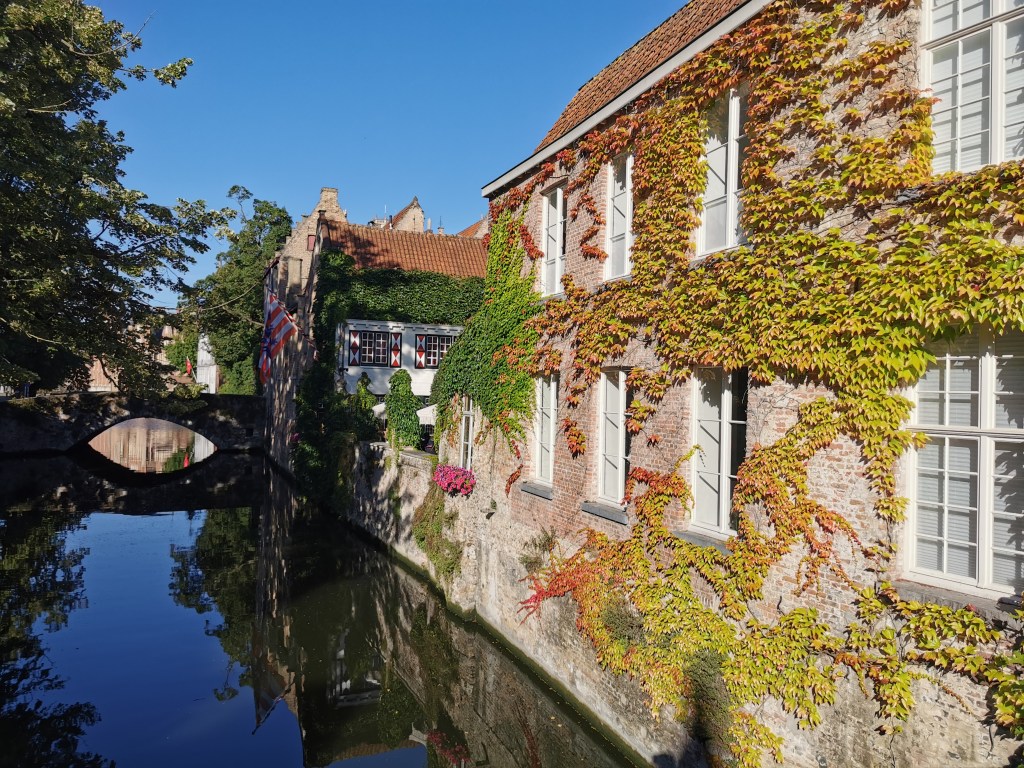
As this was our first trip abroad with our son, we wanted to make sure there was time for him to get out of his pram and have a play.
We therefore had a looked for any parks we could find that would give Jacob a chance to have a play in the grass and came across Minnewater Lake and park.
Minnewater Lake and park is located in the southern part of Bruges, just a short walk from the city centre and near the train station that you’ll arrive at. It’s easy to find as it’s situated along the popular tourist route, making it a convenient stop for anyone exploring the city. The park is easily accessible on foot or by bike, offering a peaceful retreat for both locals and visitors.
As we approached Minnewater Lake, we were greeted by a scene that’s nothing short of breathtaking. The lake’s calm waters mirror the azure skies above, creating a mesmerising, ever-changing canvas. Surrounding the lake, lush greenery, weeping willows, and colourful flowers add to the picturesque setting.
The name “Minnewater” translates to “Lake of Love” in Dutch, and this romantic moniker is rooted in a charming local legend.
According to the story, a young girl named Minna fell deeply in love with a warrior. When the warrior went off to battle, Minna passed the time by weaving a beautiful tapestry, pouring her love and longing into each thread. Sadly, the warrior never returned, and Minna’s heartache grew.
Overwhelmed by sorrow, she sought solace by the lake one fateful evening. There, she spotted a swan gliding gracefully across the water.
As she approached, the swan transformed into the spirit of her beloved warrior, soothing her heartache and taking her to the afterlife. Today, swans still grace the lake, symbolising eternal love and the enduring spirit of Minna’s story.
Minnewater Lake and park provide a tranquil escape from the hustle and bustle of Bruges’ charming streets. Whether you’re looking to relax on a park bench, take a leisurely stroll, or enjoy a quiet picnic, this serene oasis offers a space for peaceful reflection.
With its captivating beauty, rich legend, and serene ambiance, it’s a must-visit destination for anyone exploring this Belgian treasure.
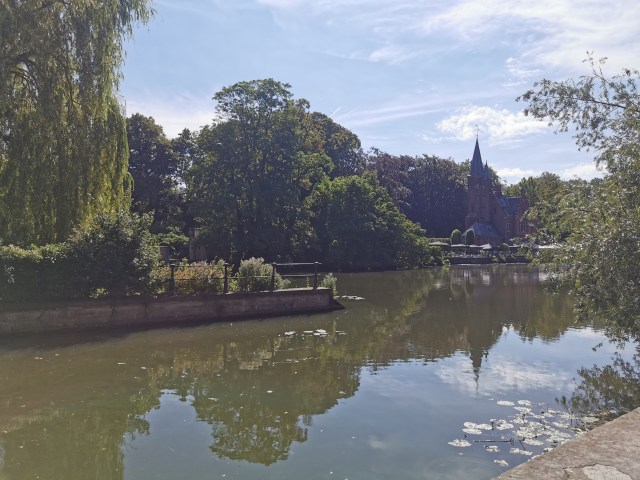

As I’ve often mentioned before, we are big fans of a free walking tour.
I find that they are a great way to get to know a city, learn a bit about its history and see some of the main sights along the way.
It’s why we decided to do one in Bruges – making it Jacob’s first ever free walking tour.
One of the largest and well publicised tours in Bruges is that of Legends Free Tours (seen around with the red umbrellas). They set off twice a day at 10:30am (the time we selected) and 2pm.
The adventure begins in the Markt square opposite the Belfort. This is where we met with our knowledgeable and passionate guide (named Eric I believe) who would then take us on a whirlwind tour of the city during a two-and-a-half hour journey into Bruges’ history and its legends.
Once we’d assembled with our fellow travellers and our guide, we set off on the carefully crafted route through the city, stopping at key landmarks and hidden gems to hear the stories and legends that have shaped Bruges into the city it is today.
As we wandered through the medieval streets and alongside the tranquil canals, we heard tales ranging from powerful merchants and artisans to legends of ghostly apparitions and romantic sagas.
One of the most remarkable aspects of Legends Free Walking Tours is their commitment to making history accessible to everyone.
At the end of the tour, you’ll have the opportunity to show your appreciation by contributing what you feel the tour was worth. This unique “pay-what-you-want” system ensures that visitors of all budgets can partake in this immersive experience without feeling financially burdened.
This approach allows you to enjoy the tour at your own pace, savouring every moment of discovery without worrying about a fixed cost. It also encourages a sense of appreciation for the guides who pour their passion and knowledge into each tour.
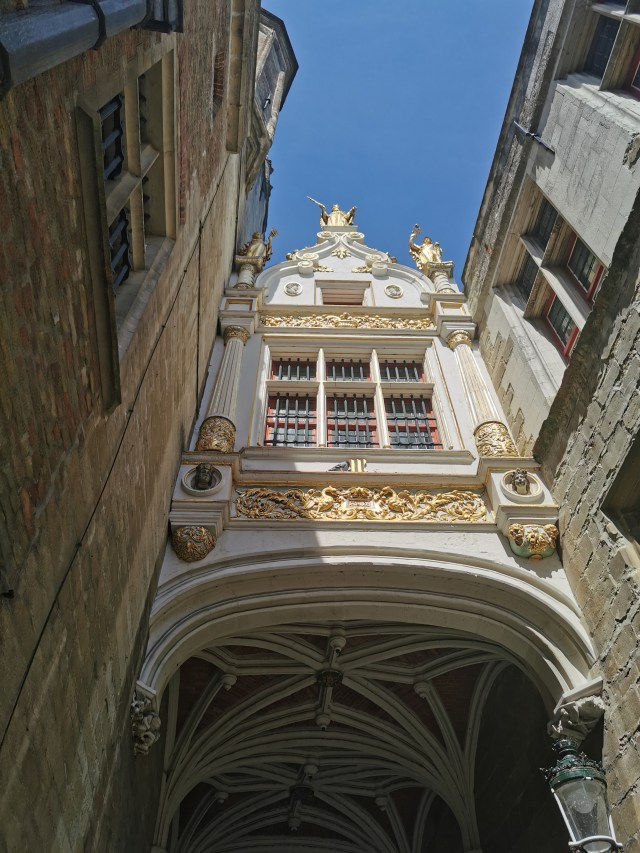

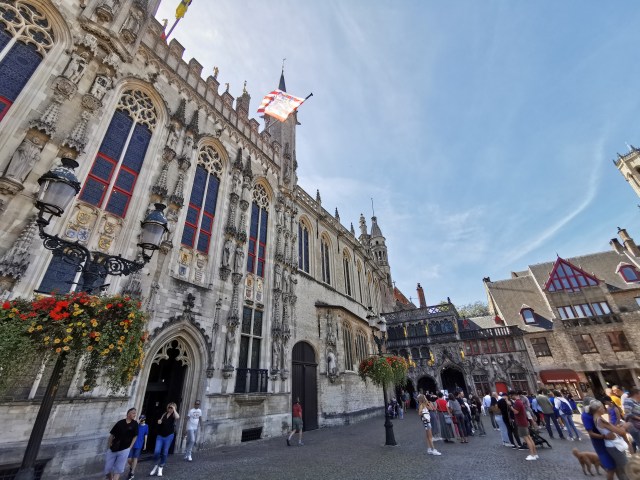
Where to avoid
If you find yourself strolling through the picturesque streets of Bruges, you’ll undoubtedly encounter numerous recommendations for places to visit and experiences to enjoy.
One such location that caught our attention was the quirky Frietmuseum – linked to the much better Choco-Story previously mentioned.
Perhaps we should have known better than to visit a museum dedicated to celebrating the humble potato and its transformation into the beloved Belgian delicacy, fries. Yet in when went anyway!
Sounding like a unique experience, we parted with our €9.50 each (Jacob was at least free) and entered.
The Frietmuseum’s main drawback is its limited content. While it claims to offer a comprehensive exploration of the history and culture surrounding Belgian fries, the museum’s exhibits are relatively small and can be covered in about an hour. For the price of admission, visitors may expect a more substantial and immersive experience.
Given the limited content and relatively short visit duration, some visitors may feel that their money could be better spent elsewhere in the city, such as enjoying a hearty portion of Belgian fries at a local street vendor.
A great museum experience often involves engaging and interactive elements that make learning enjoyable. Unfortunately, the Frietmuseum falls short in this department. Visitors mostly encounter static displays, text panels, and a few dioramas, missing the opportunity to participate in hands-on activities or engage in immersive exhibits that could truly bring the history of Belgian fries to life.
While the Frietmuseum claims to delve into the cultural aspects of Belgian fries, it may leave visitors wanting more depth. The museum focuses primarily on the history and preparation of fries, overlooking the broader cultural context of this beloved dish, such as its significance in Belgian cuisine, the regional variations, and its place in everyday life.
So, while the Frietmuseum in Bruges may initially sound like a fun experience, its limited content, relatively high admission fee, lack of interactivity, and shallow cultural insights may make it a less worthwhile choice for many travellers.
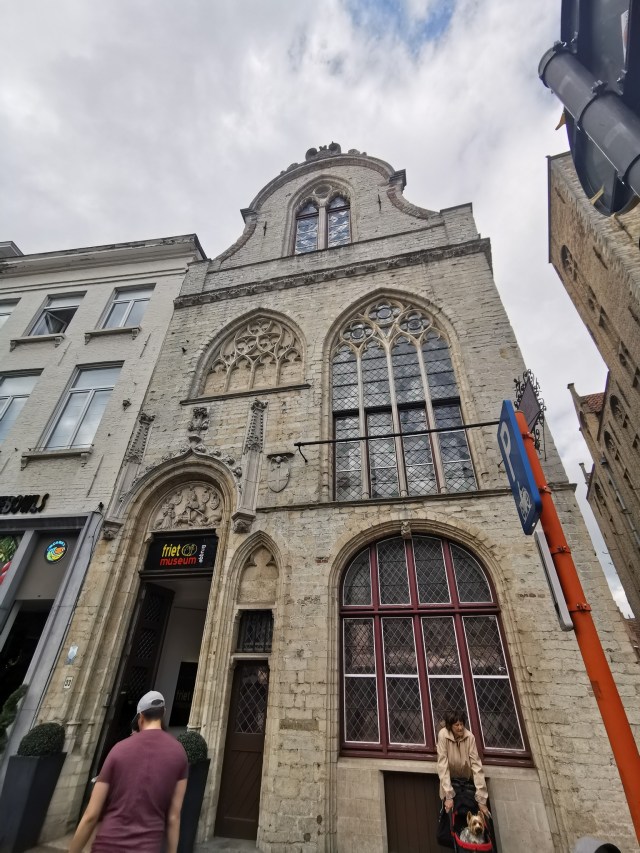


When planning a trip to the picturesque city of Bruges, one attraction that frequently finds its way onto a must-see list is the Basilica of the Holy Blood.
However, while this historic site may hold a certain allure, there are some compelling reasons why it might not be the best use of your time and money.
The Basilica is open daily from 9:30am to 12:30pm and from 2pm to 5:30pm and is free to enter. However, if you want to visit the relic itself in the treasury museum this costs €5 per person – aged 12 and over (about £4.28).
The draw of the basilica is that a small holy shroud, that apparently contains the blood of Jesus Christ on it, is here. The Relic of the Holy Blood, is said to have been brought to Bruges by the crusaders and is in the Chapel of the Holy Blood.
Despite having seen this once previously (I guess I don’t learn), Holly, Jacob and I went inside the Basilica during our visit and were prepared to pay the fee, but got lucky that they were bringing it out for a religious ceremony which allowed us to see it for free and queue up with other guests to get up close to it (albeit very briefly).
It’s this brevity that makes it slightly pointless, in my opinion.
One of the primary drawbacks of visiting the Basilica of the Holy Blood is its limited accessibility. The basilica is divided into two distinct chapels: the lower chapel and the upper chapel. To see the revered relic of the Holy Blood, you must pay for entrance to the upper chapel.
Once inside, you might be surprised by how little time you actually get to spend viewing the relic. The Holy Blood relic is displayed behind protective glass, and visitors are ushered through rather quickly. This leaves little time for reflection or appreciation of the historical and religious significance of the artifact.
Furthermore, due to its popularity, the Basilica of the Holy Blood tends to attract large crowds of tourists. This can make for a somewhat rushed and less-than-spiritual experience. The noise and jostling can detract from the solemnity one might expect when visiting a religious site.
While the Basilica of the Holy Blood may hold historical and religious significance, it may not be the best choice for all visitors to Bruges. The cost of admission, limited viewing time, and crowds can detract from the overall experience.
Exploring the many other treasures that Bruges has to offer might just leave you with a more fulfilling and enjoyable visit to this enchanting city.



Great places to eat
There are plenty of mouth-watering local delicacies to try while in Bruges and the city offers a wide range of restaurants, from cosy pubs to fine dining establishments, catering to various tastes and budgets and during our trip, Holly, Jacob and I were able to try a few fantastic local establishments.
However, unlike other blog posts where I speak about specific establishments, in this one I’ll highlight some specific Belgian treats that should not be missed and readily available throughout the city.
The first of these is perhaps something Belgium is arguably most famous for and that’s chocolate!
Revered across the globe for their exceptional quality and craftsmanship, Belgian chocolates are a testament to the country’s commitment to culinary excellence.
Artisanal chocolatiers carefully source the finest cocoa beans and masterfully transform them into delectable pralines, truffles, and bars. Each bite is an explosion of flavour, a journey through the different levels of cocoa intensity and delicate fillings.
Whether you’re a milk chocolate enthusiast or a dark chocolate connoisseur, Belgium offers a sweet symphony that’s hard to resist.
During our stay, Holly and I indulged ourselves in numerous shops selling these local treats (taking a number home with us as well) as well as sampled some of the finest hot chocolates available including a particularly tasty one in the centrally located Olivier’s Chocolate Shop & Bar.
Also, keep your eyes open for the Guild of Bruges Chocolatiers sign on some of the chocolate shop fronts in Bruges. This symbol signifies that the chocolates are actually made in Bruges (ensuring you’re getting a local flavour when you buy) as a lot of other shops import the chocolates from elsewhere.

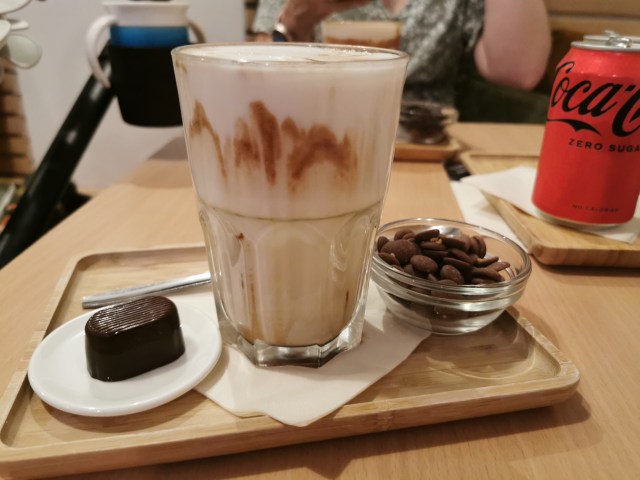
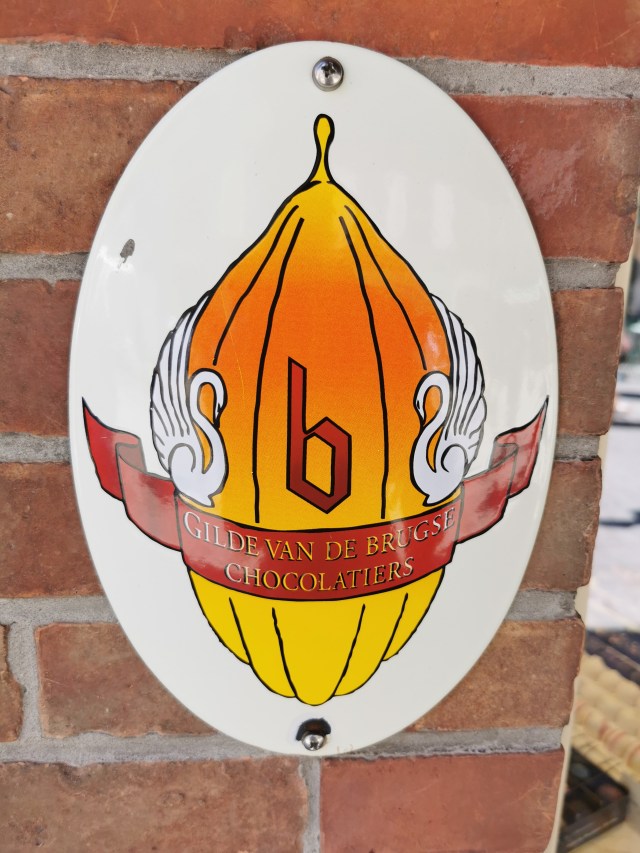
The second must try is the magnificent Belgian waffle.
These sweet (and sometime savoury) delights have become an iconic symbol of the country’s culinary prowess.
Crispy on the outside, yet delightfully light and fluffy on the inside, Belgian waffles come in two main varieties: the Brussels waffle and the Liège waffle. The Brussels waffle is rectangular with deep pockets, perfect for holding toppings like whipped cream, fresh berries, and, of course, chocolate drizzles.
The Liège waffle is smaller, rounder, and studded with caramelised sugar, providing a delightful crunch in every bite. Whichever type you choose, Belgian waffles will leave you craving more.

The third food on your itinerary should be moules-frites; a dish of steamed mussels served with crispy fries.
This is a Belgian classic that marries the bounty of the sea with the satisfaction of comfort food. The mussels are cooked in a flavourful broth, often infused with white wine, garlic, and herbs.
Paired with perfectly golden and crispy fries, this dish embodies the art of simple, yet exquisite, Belgian cuisine. The contrast of textures and flavours makes moules-frites an unforgettable dish that celebrates both land and sea.
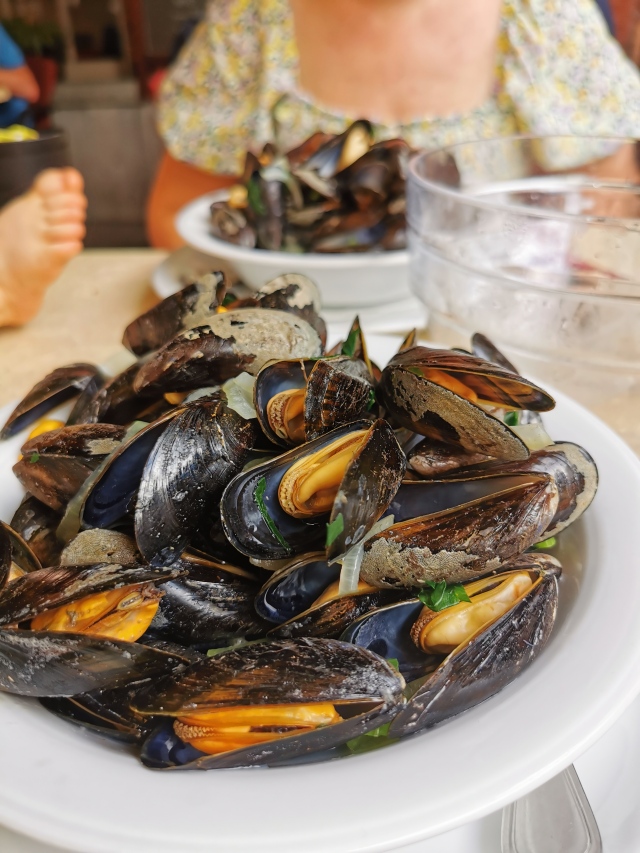
The final selection is, of course, Belgium’s fine beer. Beer is deep-rooted within the culture of Belgium having been deeply ingrained in its history and society. With a brewing tradition that dates back centuries, the country boasts an astonishing variety of beers that cater to every taste preference.
From rich and malty Trappist ales to refreshing wheat beers and sour lambics, Belgian beer is a plethora of flavours and styles. Whether you’re enjoying a beer in a cozy pub or exploring a brewery’s offerings, Belgian beer is a journey into the heart and soul of the country.

Useful links
Olivier’s Chocolate Shop & Bar
Remember you can follow World Complete on Twitter, Instagram, Pintrest, Tumblr and Facebook send your comments and pictures from your travels using #WorldComplete and #Travel.

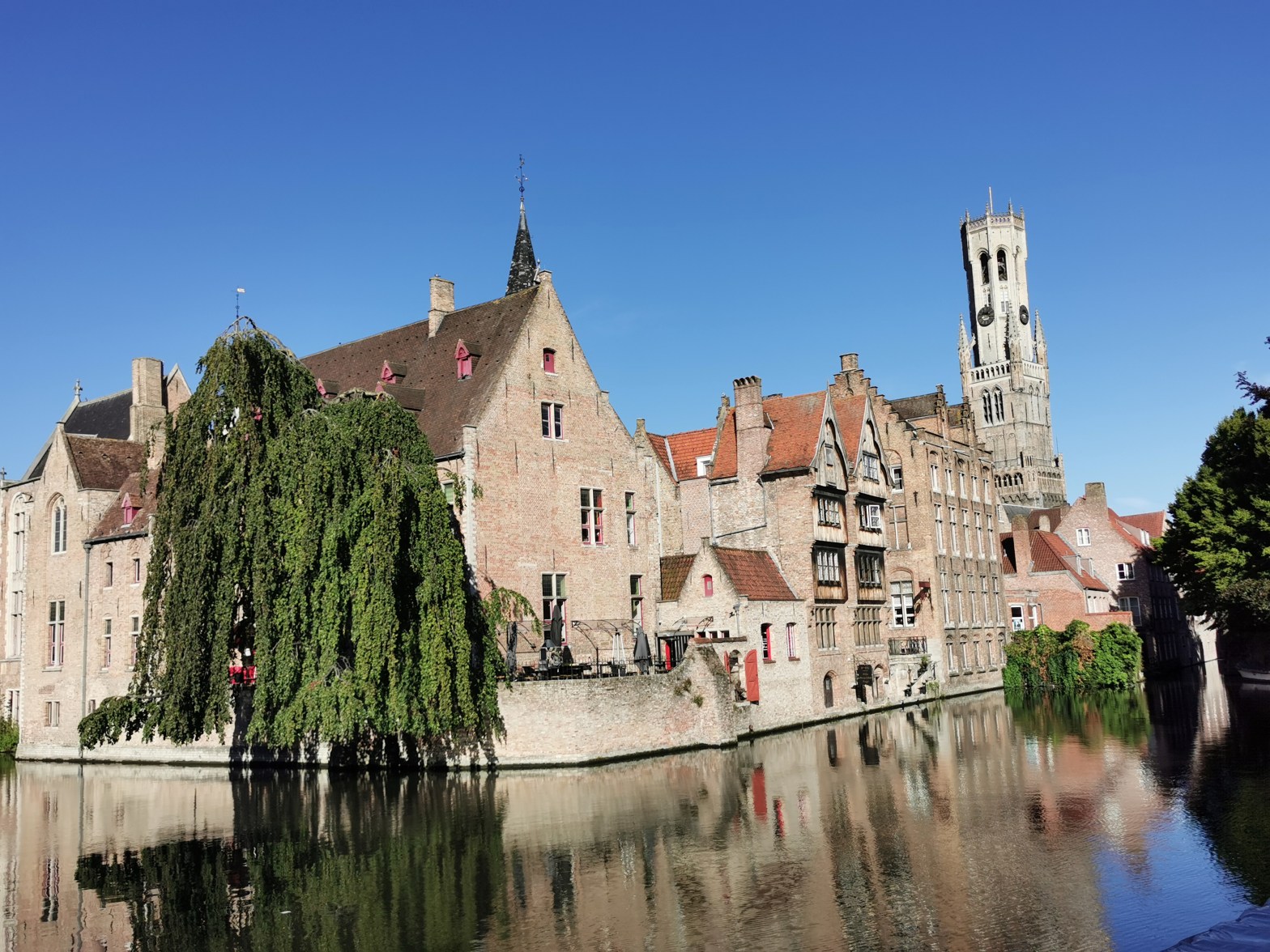
What a wonderfully detailed post. I have heard that Bruges is a lovely city and the architecture is amazing! I do love the photos with the reflection of the buildings in the water!
LikeLiked by 2 people
Thank you so much for the kind comments. I’m glad you enjoyed the blog. I hope you found it useful.
LikeLiked by 1 person
On my list. Thanks for the details!
LikeLiked by 2 people
No problem. Hope you found the blog helpful. Thanks for stopping by 🙂
LikeLiked by 1 person
Sure thing. As a travel blogger myself, it’s always nice to have a stopper by 😊
LikeLiked by 1 person
Thanks for sharing your trip to Bruges, you packed in a lot in your visit the museum on Frities sounds a fun but different place to visit, I have not been to Bruges before so I might add this to my list of places to visit 🙂
LikeLiked by 2 people
Glad you enjoyed the piece and hopefully find it useful. I’d very much suggest adding Bruges to your list of places to visit. You’ll love it! 🙂
LikeLike
Really enjoyed this blog sounds like there is a lot to see and do, adding Bruges to the travel bucket list. I’m a big fan of renaissance architecture and would love to try the moules. Thanks for sharing
LikeLiked by 2 people
Thanks so much for stopping by and glad you enjoyed the blog!
LikeLike
I love old cities and visiting historical sides. I’m going to add Bruges to my bucket list. Thank you for sharing.
LikeLiked by 2 people
Thank you so much for stopping by my blog. I’m delighted that you enjoyed my work. Glad I’ve managed to put Bruges on your bucket list 🙂
LikeLike
Wonderful post!
LikeLiked by 2 people
Thank you for the kind comment. Glad you enjoyed the post. Happy New Year 🙂
LikeLiked by 1 person
You’re more than welcome 🌹🌹🌹
Happy New Year to you too! 🌟🎇🌟
LikeLiked by 1 person
Beautifully written 👌
LikeLiked by 1 person
Thank you for the lovely comment! Hope you enjoyed the blog.
LikeLiked by 1 person